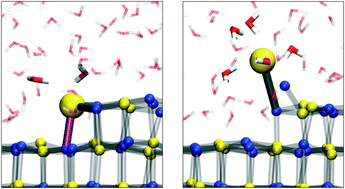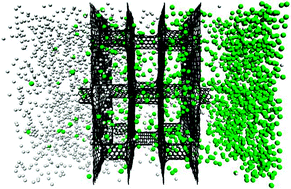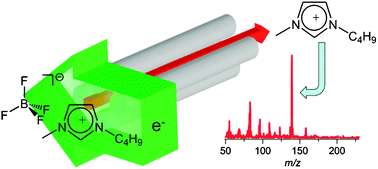Top 25 most-read PCCP articles for Q2
Characterization of nanostructured hybrid and organic solar cells by impedance spectroscopy
Francisco Fabregat-Santiago, Germà Garcia-Belmonte, Iván Mora-Seró and Juan Bisquert
DOI: 10.1039/C0CP02249G
Density functional theory for transition metals and transition metal chemistry
Christopher J. Cramer and Donald G. Truhlar
DOI: 10.1039/B907148B
Photoblinking and photobleaching of rylene diimide dyes
Mathias Haase, Christian G. Hübner, Fabian Nolde, Klaus Müllen and Thomas Basché
DOI: 10.1039/C0CP01814G
Titania supported gold nanoparticles as photocatalyst
Ana Primo, Avelino Corma and Hermenegildo García
DOI: 10.1039/C0CP00917B
Bimetallic Pt–Au nanocatalysts electrochemically deposited on graphene and their electrocatalytic characteristics towards oxygen reduction and methanol oxidation
Yaojuan Hu, Hua Zhang, Ping Wu, Hui Zhang, Bo Zhou and Chenxin Cai
DOI: 10.1039/C0CP01998D
Catalysis by metal–organic frameworks: fundamentals and opportunities
Marco Ranocchiari and Jeroen Anton van Bokhoven
DOI: 10.1039/C0CP02394A
Studying disorder in graphite-based systems by Raman spectroscopy
M. A. Pimenta, G. Dresselhaus, M. S. Dresselhaus, L. G. Cançado, A. Jorio and R. Saito
DOI: 10.1039/B613962K
Enhanced electrocatalytic performance of functionalized carbon nanotube electrodes for oxygen reduction in proton exchange membrane fuel cells
Ramaiyan Kannan, Unni Bipinlal, Sreekumar Kurungot and Vijayamohanan K. Pillai
DOI: 10.1039/C0CP02853C
Colloidal metal nanoparticles as a component of designed catalyst
Chun-Jiang Jia and Ferdi Schüth
DOI: 10.1039/C0CP02680H
Layer-by-layer assembly as a versatile bottom-up nanofabrication technique for exploratory research and realistic application
Katsuhiko Ariga, Jonathan P. Hill and Qingmin Ji
DOI: 10.1039/B700410A
Recent progress in SERS biosensing
Kyle C. Bantz, Audrey F. Meyer, Nathan J. Wittenberg, Hyungsoon Im, Özge Kurtuluş, Si Hoon Lee, Nathan C. Lindquist, Sang-Hyun Oh and Christy L. Haynes
DOI: 10.1039/C0CP01841D
Direct electro-deposition of graphene from aqueous suspensions
Matthias Hilder, Bjorn Winther-Jensen, Dan Li, Maria Forsyth and Douglas R. MacFarlane
DOI: 10.1039/C1CP20173E
Sandwich-type functionalized graphene sheet-sulfur nanocomposite for rechargeable lithium batteries
Yuliang Cao, Xiaolin Li, Ilhan A. Aksay, John Lemmon, Zimin Nie, Zhenguo Yang and Jun Liu
DOI: 10.1039/C0CP02477E
A thorough benchmark of density functional methods for general main group thermochemistry, kinetics, and noncovalent interactions
Lars Goerigk and Stefan Grimme
DOI: 10.1039/C0CP02984J
Overcoming excitonic bottleneck in organic solar cells: electronic structure and spectra of novel semiconducting donor–acceptor block copolymers
Zhenyu Guo, Samson A. Jenekhe and Oleg V. Prezhdo
DOI: 10.1039/C0CP02180F
Multiscale modeling of biological functions
Shina Caroline Lynn Kamerlin and Arieh Warshel
DOI: 10.1039/C0CP02823A
In situ Raman spectroscopy of H2 interaction with WO3 films
J. Z. Ou, M. H. Yaacob, M. Breedon, H. D. Zheng, J. L. Campbell, K. Latham, J. du. Plessis, W. Wlodarski and K. Kalantar-zadeh
DOI: 10.1039/C0CP02050H
Carbon materials for supercapacitor application
Elzbieta Frackowiak
DOI: 10.1039/B618139M
Air and water stable ionic liquids in physical chemistry
Frank Endres and Sherif Zein El Abedin
DOI: 10.1039/B600519P
Fe3O4 nanoparticle-integrated graphene sheets for high-performance half and full lithium ion cells
Liwen Ji, Zhongkui Tan, Tevye R. Kuykendall, Shaul Aloni, Shidi Xun, Eric Lin, Vincent Battaglia and Yuegang Zhang
DOI: 10.1039/C1CP20455F
Quantum mechanics/molecular mechanics methods can be more accurate than full quantum mechanics in systems involving dispersion correlations
W. M. C. Sameera and Feliu Maseras
DOI: 10.1039/C0CP02957B
In silico screening of metal–organic frameworks in separation applications
Rajamani Krishna and Jasper M. van Baten
DOI: 10.1039/C1CP20282K
A biophysical perspective of understanding nanoparticles at large
Pu Chun Ke and Monica H. Lamm
DOI: 10.1039/C0CP02891F
Hybrid simulations: combining atomistic and coarse-grained force fields using virtual sites
Andrzej J. Rzepiela, Martti Louhivuori, Christine Peter and Siewert J. Marrink
DOI: 10.1039/C0CP02981E
Hydrogen evolution via sunlight water splitting on an artificial butterfly wing architecture
Huihui Liu, QibinZhao, Han Zhou, Jian Ding, Di Zhang, Hanxing Zhu and Tongxiang Fan
DOI: 10.1039/C1CP20787C













 Ionic liquids (ILs) do not have a detectable vapour pressure at room temperature. But scientists at the University of Nottingham have managed to measure the enthalpy of vaporisation of a series of imidazolium-based ILs with the help of mass spectrometry.
Ionic liquids (ILs) do not have a detectable vapour pressure at room temperature. But scientists at the University of Nottingham have managed to measure the enthalpy of vaporisation of a series of imidazolium-based ILs with the help of mass spectrometry.